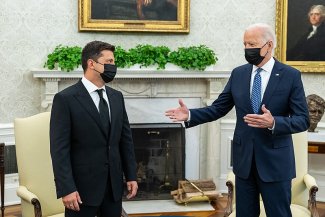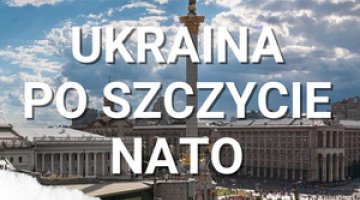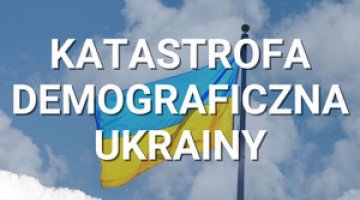Zelensky in the US – the strategic dimension of cooperation

President Volodymyr Zelensky was on a working visit to Washington DC on 31 August-1 September. The members of the Ukrainian delegation also included Deputy Prime Minister Mykhailo Fedorov, Energy Minister Herman Halushchenko and the Defence Minister Serhiy Taran. The focal point of the visit was a two-hour face-to-face meeting with President Joe Biden (this was twice as long as had been anticipated). Zelensky also spoke to Defence Secretary Lloyd Austin, Energy Secretary Jennifer Granholm and World Bank President David Malpass. A number of documents were signed, including a framework agreement on the strategic foundations of a defence partnership, a memorandum between the nuclear power plant operator Energoatom, and Westinghouse concerning the construction of five new nuclear reactors. A memorandum was also signed, on the American Export and Import Bank (EXIM Bank) granting financial support to Ukrainian projects (mainly ones of an infrastructural nature), for a total of US$3 billion.
After the presidents met, a joint Declaration on the Strategic Partnership between Ukraine and the US was published, confirming the territorial integrity of Ukraine and its opposition to Russia’s aggressive policy. The document also emphasised the issues of the US support granted so far to Ukraine and co-operation with Ukraine in the area of security. It announced the allocation of an additional US$60 million for the needs of its army, and declared the activation of the formula of permanent dialogue in the format of the bilateral Strategic Partnership Committee. This institution was established in 2018 (so far only one meeting has taken place) and was intended to provide a platform for permanent consultations between Ukraine and the US under the leadership of the heads of diplomacy of both countries. Its meeting is scheduled to take place in autumn and will be attended by the US Secretary of State Antony Blinken and the Ukrainian Foreign Minister Dmytro Kuleba. A new Strategic Partnership Charter between Ukraine and the USA will be signed.
The declaration imposes a commitment on Ukraine to continue reforms, in particular judicial reform, and to fight corruption. Although both parties recognised the construction of the Nord Stream 2 (NS2) gas pipeline as a threat to Europe’s energy security, the document did not impose on the United States an obligation to act to maintain transmission via Ukraine after the expiry of the transit contract between Gazprom and Naftogaz at the end of 2024.
Commentary
- Zelensky’s visit to Washington did not bring any breakthrough in bilateral relations. The president raised these key issues: US support for Ukraine joining NATO (including the creation of an action plan for membership), and firm US commitments to help Kyiv in the event of a radical reduction in gas transit through the Ukrainian transmission system. However, no declarations regarding these issues were made. At the same time, the visit confirmed that the US is committed to Ukraine’s security and internal modernisation. The visit has also opened a window of opportunity for a new chapter in relations between the two countries after the four years of the Donald Trump administration’s rule, when Kyiv became involved in the domestic political game in the US. The title and content of the joint declaration of the presidents, as well as the announcement of the renewal of the Strategic Partnership Committee, confirm the mutual will to raise the rank of bilateral relations. However, this will largely depend on the scale and the pace of implementation of internal reforms by the government in Kyiv.
- The talks have confirmed that the United States is a key security ally for Ukraine. The framework agreement of the defence ministries sets out the priorities for cooperation. These include: the implementation of reforms in the defence sector, enhancing cooperation in the Black Sea region, cooperation in the field of cybersecurity, the exchange of intelligence information and counteracting Russian aggression. The US confirmed that it will continue to financially support the growth of Ukraine’s defence potential. To this end, it is expected that it will allocate an additional US$60 million from the Pentagon’s budget to supply military equipment and weapons, including Javelin anti-tank missiles. It was emphasised that, since 2014, the US had spent US$2.5 billion on aid to the Ukrainian Armed Forces (this amount includes the US$400 million which has already been transferred this year). During the visit, the US Defence Secretary and the Ukrainian Minister of Defence also signed an agreement on joint ventures in the field of research, design, experiments and their evaluation in the defence industry, which opens the way for Kyiv’s possible acquisition of American technologies for the needs of modernising equipment and weapons as well as development work.
- In May this year Biden withdrew from plans to impose new sanctions on NS2 that could prevent the completion of the pipeline; this was an unpleasant surprise for Ukraine. When the pipeline is launched, Ukraine will cease to be an important gas transit country and will sustain substantial financial losses (last year, transmission revenues amounted to around US$1.5 billion). In the joint strategic partnership declaration, NS2 was branded as “a threat to European energy security”. However, no specific proposals were made for US commitments to maintain gas transit through Ukraine after 2024, when the transmission contract with Gazprom expires. On the other hand, earlier signals from Washington and an agreement between Biden and Chancellor Angela Merkel on NS2 in July this year did not indicate that Kyiv could get anything more from the Americans than general declarations of support.
- The status of the document signed by Energoatom and Westinghouse is unclear (in one version it is called a memorandum, in another it is an exclusive agreement). Westinghouse is – alongside Russia’s TWEL – one of the suppliers of fuel for Ukrainian nuclear power plants, and its products are used in 6 out of 15 local reactors. The agreement, worth up to US$30 billion, provides for the construction of five blocks using the American AP 1000 technology. One of them is to be located in the unfinished fourth block of the Khmelnytskyi Nuclear Power Plant (KNPP). The location of the others has not been specified as yet. For years, Kyiv has been trying to complete the third and fourth units of the KNPP, the construction of which was suspended in the 1980s after the Chernobyl disaster. In 2010, a deal regarding this issue was struck with Russia, but the project was not implemented. In 2014, Energoatom signed a memorandum of cooperation with the Czech corporation ŠKODA JS a.s., but no funds were found to start work. In both cases the WWER-1000 technology was to be employed. The outlook for Westinghouse’s investment remains vague – the source of financing for the construction of new units and the timeframe for the venture have not been specified. Nor is it known whether the existing infrastructure at KNPP will be compatible with AP 1000 reactors.
- The joint declaration places great emphasis on reforms in Ukraine. This involves changes in the judiciary and ensuring the independence of anti-corruption institutions — the National Anticorruption Bureau and the Special Anticorruption Prosecutor’s Office were indicated as the key priorities. Kyiv also committed to continuing reforming state-owned enterprises and to maintain the independence of the central bank. The list of requirements is not surprising and is in line with the one presented by the International Monetary Fund. However, their meticulous enumeration in the document prepared in advance is proof of growing US irritation with the Ukrainian government’s delays in introducing the changes and a sign that the US does not intend to reduce the pressure in this case.
- The visit to Washington was the culmination of the Ukrainian government’s efforts to meet with the American president. The Ukrainian officials had very high expectations after Biden’s victory. When Biden served as vice-president in the administration of Barack Obama, his responsibilities included relations with Ukraine. At that time he maintained personal contacts with Ukrainian politicians and he is very well familiar with the situation in Ukraine. Nevertheless, the first months of his presidency showed that the US did not intend to increase its involvement there. Ukraine did not persuade the US to become more actively engaged in settling the conflict in Donbas (it did not even receive a promise of NATO membership) and the decision to suspend sanctions against NS2 caused disappointment. Therefore, Zelensky’s visit to the United States should be seen primarily as an opportunity for him to establish a personal relationship with the US President.




